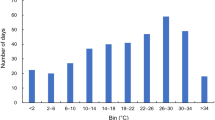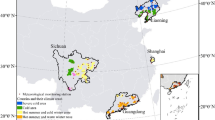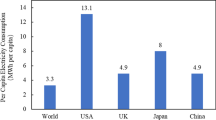Abstract
Energy consumption is a chief contributor to climate change, which increases as households use more air conditioning (AC) in response to climate change. As such, climate change–induced energy consumption is expected to increase more drastically in fast-emerging economies, where the rapidly increasing household income and urbanization promote the large-scale adoption of ACs. Based on data on daily household electricity consumption in the Zhejiang Province of China, this study estimates the household temperature response functions. In particular, we consider urban and rural households with and without AC to chart their various cooling demand and consumption behavior, typically indicated by U-shaped temperature-response functions. Compared to rural households and those without AC, urban households and those with AC exhibit steeper response functions at both high and low temperatures. Based on these estimates, we simulate the household electricity consumption under climate change scenarios RCP4.5 and RCP8.5. The simulation results reveal that (1) under constant urbanization and AC adoption rates, the electricity consumption in the residential sector will increase by 5.04–16.37% because of climate change; (2) as the AC adoption rate increases from 82.50 to 95.00% in urban areas and from 74.40 to 85.00% in rural areas, the household electricity consumption in Zhejiang Province will further increase by 0.52–1.05%; (3) combined with the increase of urbanization from 68.73 to 80.00%, the increase rate of annual electricity consumption of the residential sector will further rise to 25.60–55.79%. These findings highlight the vicious cycle of climate change and cooling along with the challenges encountered by electricity grids.



Similar content being viewed by others
Data availability
The datasets analyzed herein are not publicly available because of the data confidentiality agreement with the State Grid Corporation of China, but they are available from the corresponding author upon reasonable request.
Notes
IEA, Global Energy Review: CO2 Emissions in 2020, https://www.iea.org/articles/global-energy-review-co2-emissions-in-2020)
Source: China Statistical Yearbook 2020
Source: U.S. Energy Information Administration, https://www.eia.gov/electricity/data/browser
The ACs studied herein include appliances with both heating and cooling functions, which are common among the investigated samples.
Source: Zhejiang Statistical Yearbook 2022
The observations with extreme load are excluded based on two criteria. First, the households report the operation of restaurants or accommodation/shops in their houses during the survey. Second, the average daily electricity consumption exceeds 100 kWh, which is nearly 20 times that of the sample.
Herein, the four seasons are classified according to the "Division of Climatic Seasons" issued by the China Meteorological Administration (https://std.samr.gov.cn/gb/search/gbDetailed?id=5DDA8B9DC86C18DEE05397BE0A0A95A7). Specifically, the onset of summer is marked by a daily average temperature of greater than 22°C for five consecutive days. Conversely, the onset of winter is confirmed by a daily average temperature of less than 10°C for five consecutive days. Thus, according to the daily average temperature in Zhejiang in 2017 and considering the comparability between the seasons, we regard every 3 months as a season, i.e., summer prevails from June to August, whereas winter spans from December to February.
The NEX-GDDP provides air-temperature forecast data from 21 General Circulation Models for both RCP4.5 and RCP8.5 scenarios. The projections detail the forecasts of daily maximum and minimum temperatures with a spatial resolution of 0.25° × 0.25°. Based on these data, we utilize the average of maximum and minimum temperatures as a proxy for daily average temperature and calculate the mean temperature of 21 models to develop the scenarios applicable herein.
In total, 15 dummy variables are used to represent 16 orientations.
According to China’s Regulation on Public Holidays for National Annual Festivals and Memorial Days, we include New Year, Spring Festival, Tomb-sweeping Day, Labor Day, Dragon Boat Festival, Mid-Autumn Festival, and National Day in the variable Holidayt.
The lower limit represents the response of households without AC, whereas the upper limit indicates the response of households with AC.
IEA’s The Future of Cooling in China Report predicts that by 2030 as many as 85% of households are expected to own at least one AC unit.
References
Aebischer B, Catenazzi G, Jakob M (2007) Impact of climate change on thermal comfort, heating and cooling energy demand in Europe. Paper presented at the Proceedings ECEEE 2007 Summer Study “Saving Energy — Just Do It!”. Available at: http://www.verozo.be/sites/verozo/files/files/Impact%20ClimateChange_ETH%20Switzerland.pdf
Akpinar-Ferrand E, Singh A (2010) Modeling increased demand of energy for air conditioners and consequent CO2 emissions to minimize health risks due to climate change in India. Environmental Science & Policy 13(8):702–712
Auffhammer M (2014) Cooling China: the weather dependence of air conditioner adoption. Frontiers of Economics in China 9(1):70–84
Auffhammer M (2022) Climate adaptive response estimation: short and long run impacts of climate change on residential electricity and natural gas consumption. J Environ Econ Manag 114:102669. https://doi.org/10.1016/j.jeem.2022.102669
Auffhammer M, Aroonruengsawat A (2011) Simulating the impacts of climate change, prices and population on California’s residential electricity consumption. Climatic Change 109(1):191–210
Auffhammer M, Baylis P, Hausman CH (2017) Climate change is projected to have severe impacts on the frequency and intensity of peak electricity demand across the United States. Proceedings of the National Academy of Sciences 114(8):1886–1891
Biddle J (2008) Explaining the spread of residential air conditioning, 1955–1980. Explorations in Economic History 45(4):402–423
Considine TJ (2000) The impacts of weather variations on energy demand and carbon emissions. Resource and Energy Economics 22(4):295–314
Davis LW, Gertler PJ (2015) Contribution of air conditioning adoption to future energy use under global warming. Proceedings of the National Academy of Sciences 112(19):5962–5967
Deschênes O, Greenstone M (2011) Climate change, mortality, and adaptation: evidence from annual fluctuations in weather in the US. American Economic Journal: Applied Economics 3(4):152–185
Engle RF, Granger CW, Rice J, Weiss A (1986) Semiparametric estimates of the relation between weather and electricity sales. Journal of the American Statistical Association 81(394):310–320
Franco G, Sanstad AH (2008) Climate change and electricity demand in California. Climatic Change 87(1):139–151
Gertler PJ, Shelef O, Wolfram CD, Fuchs A (2016) The demand for energy-using assets among the world's rising middle classes. American Economic Review 106(6):1366–1401
Isaac M, Van Vuuren DP (2009) Modeling global residential sector energy demand for heating and air conditioning in the context of climate change. Energy Policy 37(2):507–521
Lam JC (1998) Climatic and economic influences on residential electricity consumption. Energy Conversion and Management 39(7):623–629
Li Y, Pizer WA, Wu L (2019) Climate change and residential electricity consumption in the Yangtze River Delta, China. Proceedings of the National Academy of Sciences 116(2):472–477
McNeil MA, Letschert VE (2008) Future air conditioning energy consumption in developing countries and what can be done about it: the potential of efficiency in the residential sector. Lawrence Berkeley National Laboratory, Berkeley. Available at: https://escholarship.org/uc/item/64f9r6wr
McNeil MA, Letschert VE (2010) Modeling diffusion of electrical appliances in the residential sector. Energy and Buildings 42(6):783–790
Rapson D (2014) Durable goods and long-run electricity demand: evidence from air conditioner purchase behavior. Journal of Environmental Economics and Management 68(1):141–160
Sailor DJ, Muñoz JR (1997) Sensitivity of electricity and natural gas consumption to climate in the USA—methodology and results for eight states. Energy 22(10):987–998
Sailor DJ, Pavlova A (2003) Air conditioning market saturation and long-term response of residential cooling energy demand to climate change. Energy 28(9):941–951
Salvo A (2018) Electrical appliances moderate households’ water demand response to heat. Nature Communications 9(1):1–14
Schlenker W, Roberts M (2008) Estimating the impact of climate change on crop yields: the importance of nonlinear temperature effects. Working Paper 13799, National Bureau of Economic Research, Cambridge. http://www.nber.org./papers/w13799
Suits DB (1984) Dummy variables: mechanics v. interpretation. Rev Econ Stat 66(1):177–180. https://doi.org/10.2307/1924713
Acknowledgements
The authors would appreciate the valuable comments from the editor and two anonymous referees that helped to improve the paper significantly. The authors would like to thank Fei Chen from the Economics and Technology Research Institute at State Grid Zhejiang Electric Power Corporation for his survey support.
Funding
The authors received funding from the National Natural Science Foundation of China (Grant No. 72141308, 71703163), the Research Funds of Renmin University of China (Grant No. 22XNLG12, 17XNS001, 11XNL004), and the Major Innovation & Planning Interdisciplinary Platform for the “Double-First Class” Initiative.
Author information
Authors and Affiliations
Contributions
Cui wrote the original draft, modeled the electricity response function, performed the climate change scenario analysis, and visualized all the figures in the article. Xie proposed the concept of this study and significantly contributed toward writing, reviewing, and editing this article. Zheng proposed the concept of this study and acquired relevant data.
Corresponding author
Ethics declarations
Competing interests
The authors declare no competing interests.
Additional information
Publisher’s note
Springer Nature remains neutral with regard to jurisdictional claims in published maps and institutional affiliations.
Supplementary information
ESM 1
(DOCX 1514 kb)
Rights and permissions
Springer Nature or its licensor (e.g. a society or other partner) holds exclusive rights to this article under a publishing agreement with the author(s) or other rightsholder(s); author self-archiving of the accepted manuscript version of this article is solely governed by the terms of such publishing agreement and applicable law.
About this article
Cite this article
Cui, J., Xie, L. & Zheng, X. Climate change, air conditioning, and urbanization—evidence from daily household electricity consumption data in China. Climatic Change 176, 106 (2023). https://doi.org/10.1007/s10584-023-03589-y
Received:
Accepted:
Published:
DOI: https://doi.org/10.1007/s10584-023-03589-y




